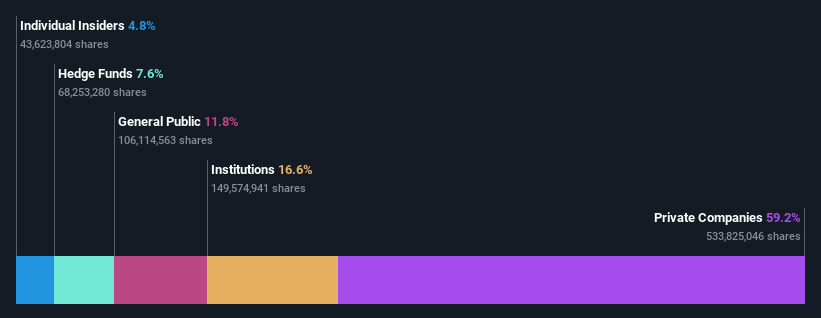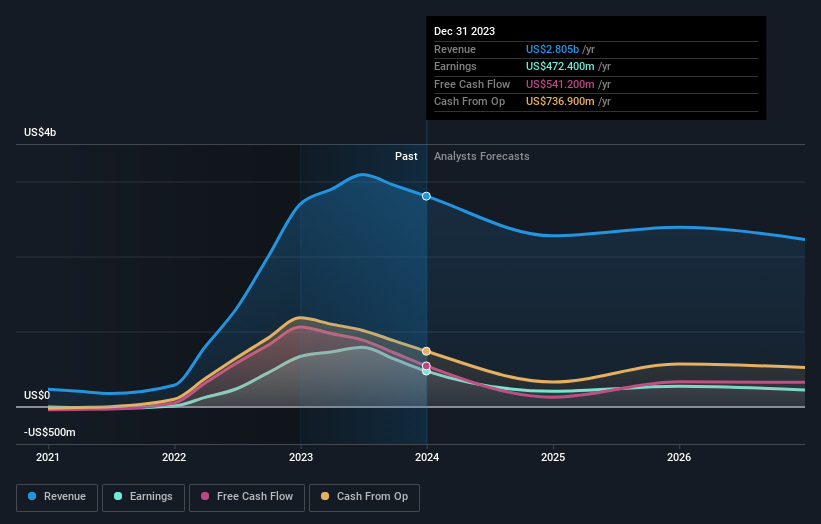Stock Analysis
- Australia
- /
- Metals and Mining
- /
- ASX:SMR
Institutions profited after Stanmore Resources Limited's (ASX:SMR) market cap rose AU$90m last week but private companies profited the most

Key Insights
- Stanmore Resources' significant private companies ownership suggests that the key decisions are influenced by shareholders from the larger public
- The largest shareholder of the company is Star Success Pte Ltd with a 59% stake
- Insiders have bought recently
To get a sense of who is truly in control of Stanmore Resources Limited (ASX:SMR), it is important to understand the ownership structure of the business. With 59% stake, private companies possess the maximum shares in the company. In other words, the group stands to gain the most (or lose the most) from their investment into the company.
While private companies were the group that benefitted the most from last week’s AU$90m market cap gain, institutions too had a 17% share in those profits.
Let's take a closer look to see what the different types of shareholders can tell us about Stanmore Resources.
See our latest analysis for Stanmore Resources

What Does The Institutional Ownership Tell Us About Stanmore Resources?
Many institutions measure their performance against an index that approximates the local market. So they usually pay more attention to companies that are included in major indices.
We can see that Stanmore Resources does have institutional investors; and they hold a good portion of the company's stock. This can indicate that the company has a certain degree of credibility in the investment community. However, it is best to be wary of relying on the supposed validation that comes with institutional investors. They too, get it wrong sometimes. It is not uncommon to see a big share price drop if two large institutional investors try to sell out of a stock at the same time. So it is worth checking the past earnings trajectory of Stanmore Resources, (below). Of course, keep in mind that there are other factors to consider, too.

It would appear that 7.6% of Stanmore Resources shares are controlled by hedge funds. That's interesting, because hedge funds can be quite active and activist. Many look for medium term catalysts that will drive the share price higher. Looking at our data, we can see that the largest shareholder is Star Success Pte Ltd with 59% of shares outstanding. This implies that they have majority interest control of the future of the company. Regal Partners Limited is the second largest shareholder owning 7.6% of common stock, and Matthew Latimore holds about 4.8% of the company stock. Matthew Latimore, who is the third-largest shareholder, also happens to hold the title of Member of the Board of Directors.
While studying institutional ownership for a company can add value to your research, it is also a good practice to research analyst recommendations to get a deeper understand of a stock's expected performance. Quite a few analysts cover the stock, so you could look into forecast growth quite easily.
Insider Ownership Of Stanmore Resources
The definition of an insider can differ slightly between different countries, but members of the board of directors always count. The company management answer to the board and the latter should represent the interests of shareholders. Notably, sometimes top-level managers are on the board themselves.
Insider ownership is positive when it signals leadership are thinking like the true owners of the company. However, high insider ownership can also give immense power to a small group within the company. This can be negative in some circumstances.
Shareholders would probably be interested to learn that insiders own shares in Stanmore Resources Limited. This is a big company, so it is good to see this level of alignment. Insiders own AU$143m worth of shares (at current prices). Most would say this shows alignment of interests between shareholders and the board. Still, it might be worth checking if those insiders have been selling.
General Public Ownership
The general public, who are usually individual investors, hold a 12% stake in Stanmore Resources. While this size of ownership may not be enough to sway a policy decision in their favour, they can still make a collective impact on company policies.
Private Company Ownership
It seems that Private Companies own 59%, of the Stanmore Resources stock. Private companies may be related parties. Sometimes insiders have an interest in a public company through a holding in a private company, rather than in their own capacity as an individual. While it's hard to draw any broad stroke conclusions, it is worth noting as an area for further research.
Next Steps:
I find it very interesting to look at who exactly owns a company. But to truly gain insight, we need to consider other information, too. Consider for instance, the ever-present spectre of investment risk. We've identified 3 warning signs with Stanmore Resources (at least 1 which is a bit unpleasant) , and understanding them should be part of your investment process.
Ultimately the future is most important. You can access this free report on analyst forecasts for the company.
NB: Figures in this article are calculated using data from the last twelve months, which refer to the 12-month period ending on the last date of the month the financial statement is dated. This may not be consistent with full year annual report figures.
Valuation is complex, but we're helping make it simple.
Find out whether Stanmore Resources is potentially over or undervalued by checking out our comprehensive analysis, which includes fair value estimates, risks and warnings, dividends, insider transactions and financial health.
View the Free AnalysisHave feedback on this article? Concerned about the content? Get in touch with us directly. Alternatively, email editorial-team (at) simplywallst.com.
This article by Simply Wall St is general in nature. We provide commentary based on historical data and analyst forecasts only using an unbiased methodology and our articles are not intended to be financial advice. It does not constitute a recommendation to buy or sell any stock, and does not take account of your objectives, or your financial situation. We aim to bring you long-term focused analysis driven by fundamental data. Note that our analysis may not factor in the latest price-sensitive company announcements or qualitative material. Simply Wall St has no position in any stocks mentioned.
About ASX:SMR
Stanmore Resources
Stanmore Resources Limited engages in the exploration, development, production, and sale of metallurgical coal in Australia.
Flawless balance sheet and good value.

